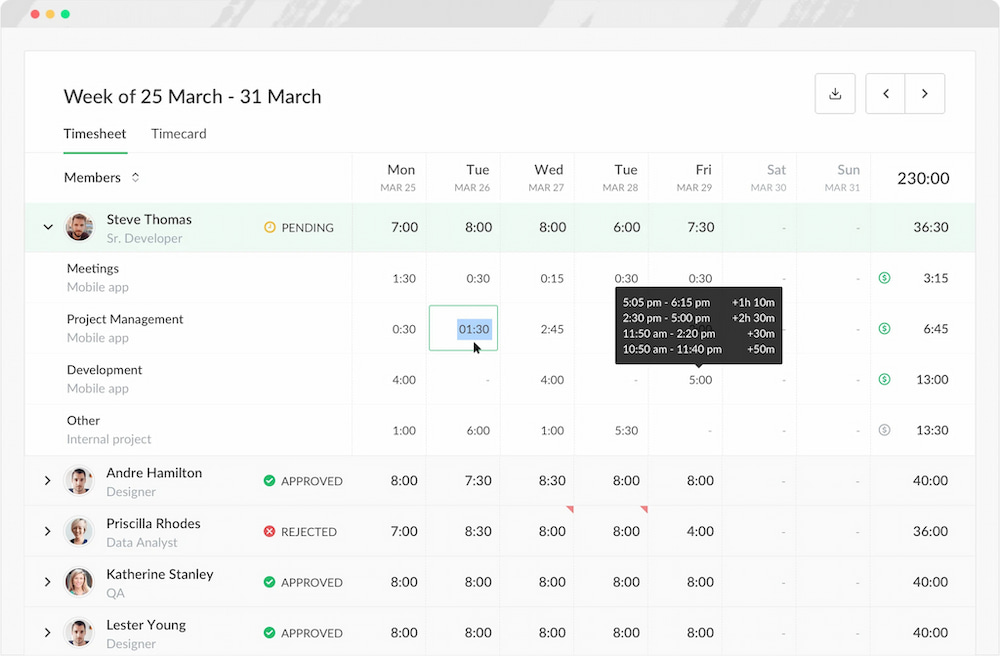Imagine this: two employees start on the same day. One is given routine tasks, no feedback, and no growth opportunities. The other gets mentoring, clear goals, and regular skill-building sessions. Fast-forward one year — the second employee is thriving, engaged, and leading projects. The first is quietly updating their LinkedIn. That contrast captures the power of employee development — the ongoing process of improving skills, knowledge, and career potential. In 2025, when remote work, AI, and generational shifts are redefining the workplace, development isn’t just a perk — it’s the cornerstone of employee retention and performance.
This article breaks down what employee development means, key strategies and methods that work, and how to create an effective plan. You’ll also see how tools like Everhour‘s time tracker can help managers connect growth goals with real productivity data — closing the loop between learning and performance.
🌱 What Is Employee Development?
Employee development is the structured process of helping employees grow their skills, knowledge, and employee experience to improve both individual performance and organizational success.
Unlike one-time training, development is continuous — a long-term investment in people. It may include mentoring, coaching, workshops, online learning, job rotations, and leadership tracks.

💡 Why it matters in 2025
The nature of work is changing fast. Automation and AI are redefining roles. Millennials and Gen Z workers are prioritizing learning opportunities over static career paths. Companies that don’t invest in development face higher turnover and skill gaps that are increasingly expensive to fill.
📈 Organizations that actively invest in employee development experience 34% higher retention rates and 24% greater productivity than those that don’t.
Employee development is no longer an HR function — it’s a competitive advantage.
🧠 The Core Pillars of Employee Development
🌱 1. Skill development
Upskilling and reskilling are at the heart of employee development. Whether through online courses or internal workshops, skill building ensures employees can adapt to evolving business demands.
🗣️ 2. Performance feedback and coaching
Regular feedback connects development goals with measurable performance. Coaching creates alignment — turning performance reviews into growth conversations rather than checkboxes.
🎯 3. Career pathing
Employees are more likely to stay when they see a clear trajectory. Effective development plans map out short- and long-term goals that connect individual growth to company needs.
📚 4. Learning culture
A company culture that values curiosity and continuous learning encourages employees to take ownership of their growth. Leaders play a critical role in modeling this behavior.

📊 5. Measurable outcomes
Without metrics, development programs drift into “nice to have” territory. Measuring progress — through performance metrics, employee engagement surveys, or time-tracking data — turns learning into business impact.
📕 Employee Development Strategies That Work
Employee development isn’t one-size-fits-all. The best strategies combine structure with flexibility, adapting to individual strengths and organizational goals.
📘 1. Continuous learning frameworks
Encourage employees to learn weekly through micro-learning, e-learning, or skill-based workshops. Platforms like Coursera, LinkedIn Learning, or internal academies can deliver scalable results.
🤝 2. Mentorship and peer learning
Mentorship builds trust, accountability, and knowledge transfer. Pair junior employees with senior mentors to accelerate both personal and professional growth.
🔄 3. Job rotation and cross-training
Moving employees across roles or departments boosts engagement and exposes them to new challenges. It’s a win-win — employees grow while businesses build flexibility into their teams.
🧭 4. Personalized development plans
No two employees have identical goals. Personalized plans — co-created between managers and employees — ensure relevance, motivation, and clear accountability.
🏆 5. Leadership development programs
Identifying and training future leaders early prepares your organization for long-term stability. Leadership programs focusing on emotional intelligence, communication, and decision-making are vital.
👀 Common Employee Development Methods
| Method | Description | Best For |
| On-the-job training | Hands-on learning during regular work tasks | Skill building and practical application |
| Mentorship programs | Pairing junior staff with experienced mentors | Career growth and confidence |
| Workshops & Seminars | Instructor-led group learning | Teamwide skill upgrades |
| E-learning platforms | Online, flexible courses | Self-paced development |
| Performance coaching | 1:1 feedback and goal alignment | Improving productivity and mindset |
| Stretch assignments | Temporary challenging tasks | Leadership readiness and engagement |
🟢 How Everhour Supports Employee Development
Employee development doesn’t exist in a vacuum — it’s deeply tied to how people work, track time, and set goals. Everhour, a leading time tracking and productivity platform, helps managers connect development initiatives directly with measurable outcomes. Here’s how:
- ⏱️ Track time on learning initiatives: Identify how much time employees spend on training or upskilling.

- 💡 Measure ROI: Compare time invested in development against improved project efficiency.
- 📊 Spot workload patterns: Use time reports to balance development with project demands.
- 🎯 Goal alignment: Integrate Everhour with project management tools (like Asana or Trello) to link learning milestones with performance goals.
By turning qualitative development goals into quantifiable data, Everhour helps organizations prove — and improve — the impact of their development efforts.
☝️ How to Create an Employee Development Plan
Creating a plan requires both structure and empathy. Here’s a simple framework:
- Assess current ckills: Identify strengths and gaps using performance data or self-assessments.
- Set clear goals: Use the SMART framework — specific, measurable, achievable, relevant, time-bound.
- Choose the right methods: Combine mentoring, training, and on-the-job learning.
- Align with company objectives: Connect development goals to strategic business outcomes.
- Assign accountability: Both managers and employees should take ownership of progress.
- Track and review: Use analytics and feedback to measure progress and adjust the plan regularly.
🤔 How to Improve Employee Development in the Workplace
Improving development isn’t just about more training — it’s about making learning a daily habit and part of your company culture.
- 📊 Conduct quarterly skill audits: Identify evolving skill gaps and areas for growth.
- ⚡ Introduce learning sprints: Short, focused challenges to accelerate skill development.
- 🔄 Use 360-degree feedback: Spot soft skill gaps and improvement opportunities.
- 💻 Leverage technology: Tools like Everhour track performance, learning time, and workload balance.
- 🎓 Encourage self-directed growth: Offer learning stipends, certifications, or courses to motivate employees.
❓FAQ: Employee Development
What is employee development?
Helping employees grow skills, knowledge, and experience to advance their careers and improve company performance.
Why is it important?
It increases engagement, retention, and innovation for both employees and the organization.
What are the best methods?
Mentorship, on-the-job training, e-learning, workshops, and leadership programs.
How can managers help?
Set clear goals, give feedback, provide time for learning, and track progress.
What makes a plan effective?
Personalized goals, measurable results, manager support, and ongoing feedback.
💡 Final Thoughts
Employee development isn’t optional — it’s essential. Companies that invest in growth attract and retain top talent, while those that don’t face higher turnover and disengagement.
The best organizations make development part of everyday work, linking learning to outcomes, mentorship to results, and purpose to performance.
Everhour helps you track learning time, measure its impact, and make development a daily habit — because when employees grow, the whole company benefits.

